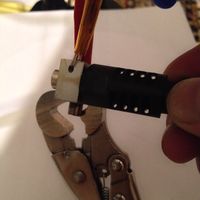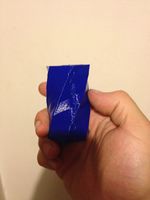Delta Rostock mini G2s
| |
Not Open Source
As stated in the RepRap Wiki Policy, a wiki page that describes a product offered for sale must provide source files for that product. This page is missing at least these item(s)
There might be more items missing. If you want to help improve this design, please find source files for these missing items and upload them to this wiki, or link to the repository containing them. In accordance with the Deletion policy, an admin will review this page in about three weeks to determine if it should be removed or not. If source files are not uploaded by the proposed delete date, this page will be removed from the wiki. Proposed delete date: {{{deletedate}}} Questions about this tag can be addressed on this page's discussion page or on the Administration, Announcements, Policy forum. |
This Rostock mini G2s is a companion piece of our new upgraded delta 3D printer -Rostock mini G2. G2s is designed to support dual extruder. With G2s you can print a single two-color object, or you can print two objects in one print job, each made from a different color. You can also print one single-color object, as with other single-extruder 3D printers. Or you can use one extruder for infill or support. The 2 extruder motor pushes filament through 2 head separately, so mixing colors printing is not applicable for the moment. This G2s is powered by our newly designed control system—GT2560 that supports 2 extruders and eliminates the complicated wiring of Mega2560+Ramps 1.4 and it is more space-saving. An auto-leveling auto-calibration device is also added on G2; which means you do not have to adjust it every time before you start printing, after the first assembly work, you can almost plug and play. In terms of printing filament, G2s not only support PLA and ABS, Nylon and wood filament is also available, which enables more possibilities to create 3D printing project. This G2s is also improved with LCD control panel; you can monitor the printing process in real time and with a SD card it can realize stand-alone printing, very convenient.
Contents
Main features:
- With dual extruder, support multiple way of printing.
- Support PLA, ABS, Nylon and Wood, giving more possibilities to create 3D printing project.
- New updated control system.
- Auto-leveling and auto-calibration.
- More flexible effectors and diagonal rods.
- More fluent printing process and higher precession.
Specifications:
Print Volume: 170 x 200mm
Chassis: laser -cut acrylic plate
The Layer Thickness: 0.1mm
Layer Resolution: 0.1mm
Filament Diameter: 1.75, 3mm
Nozzle Diameter: 0.3, 0.35, 0.4, 0.5mm
Print Speed: 60 to 120 mm/sec
Print Plate Size: 210 x 3mm
Print Plate (Build Platform): aluminum plate + heatbed
XYZ Bearings: carbon steel
Stepper Motors: 1.8° step angle with 1/16 micro-stepping
Max Heated Bed Temp: about 110 ℃
Max Extruder Temp: about 240 ℃
AC Input: 115V/1.5A 230V/0.75A
Output:DC12V/0-15A
No. of Extruders: 2
Connectivity (Interface): USB, SD Card
Electronics: Geeetech GT2560
3D printing Software: Repetier Host
CAD Input data file format supported: STL, G code
Client Operating System: Windows, Linux, Mac
Machine Dimensions: 320 x 320 x 870mm
Machine weight:9kg
Shipping box dimensions:495*395*195mm
Shipping box weight:10kg
BOM
download the BOM here Media:Delta Rostock mini G2 Package List.pdf
Sources
Download the .STL file for the printed part here
Troubleshooting
J-Head Leaks
If plastic oozes out between the PEEK cold region and the metal hot end, you may need to heat-tighten the J-Head.
First, a note of warning - until you have verified and calibrated the operation of your hot end/thermistor combination, DO NOT SET THE EXTRUDER ABOVE 200C.
Without the active cooling fan, the PEEK cylinder could begin to melt at approx 240C. If you are using the default hot end fan connection to PWM FAN, you can easily exceed the melting point of the PEEK cylinders if you set the hot-end temperature above 220C. To be safe, set the hot end to at or below 200C.
Since PEEK slightly expands when heated, if the J-Head was too cold when initially assembled, the PEEK threads will loosen once the PEEK reaches target temperature, and will allow plastic to ooze out between the threads.
The solution is as follows:
- Heat the J-Head up to approx 200C (using your G-Code sender, RepetierHost is what Geeetech suggests), and let it "soak" at 200C for approx 5 minutes.
- Using a vice-grip on the metal heater block of the J-Head (making sure not to clamp onto the nozzle!), loosen the heater block by a quarter turn
- Wipe off any excess plastic from the heater block and PEEK cylinder with a dry paper towel.
- Be careful not to wipe the nozzle - you can easily plug up a 0.3mm nozzle with paper fibers.
- Tighten the heater block to a snug fit.
Do not over-tighten the J-Head! A snug fit is all that is needed - too much force will break the PEEK threads and destroy the head.
NOTE: For the G2s model, you may need to disassemble the spider's J-Head holder to be able to loosen and tighten the heater block.
G2s Misaligned Hot Ends
If you are getting prints on a G2s where the second J-Head's nozzle tip is hitting your print, then the one of your hot ends needs to be tightened.
This is especially visible on spiral-vase prints, and a spiral vase is a great object to use for this type of calibration. Make sure to have both J-Heads heated, so that you can see a blemish, instead of the interfering hot end causing a mechanical jam!
If your left J-Head nozzle is hitting the print while the right J-Head is extruding, tighten your left J-Head's hot end 1/8th of a turn.
If your right J-Head nozzle is hitting the print while the left J-Head is extruding, tighten your right J-Head's 1/8th of a turn.
If adjusting the hot-end is not able to eliminate the interference, add a 4mm washer (Bag #6) between the top retaining bracket and spider, where the 4mm bolt passes through. If the front J-Head is interfering, add a 4mm washer to the front, and if the rear J-Head is interfering, add a 4mm washer to the back.
Repetier Firmware Configuration
This is my (User:Ezrec's) first cut at a Repetier firmware config (0.91).
NOTE: If your Z Probe has any side to side or back to front wiggle, do not use autoprobing! Your head will tilt and slide all over the place, and you may damage your nozzle.
NOTE: This firmware config was built for a RAMPS 1.4 hardware, and has not been tested on the GT2560 controller. Use at your own risk.
Firmware config for Repetier 0.91: File:Delta Rostock mini G2s MOD Repetier 0.91 Configuration.h.
This configuration file has the full JSON config in it, so feel free to feed it back into Repetier's web-based configuration generator to build a firmware for a different version.
set up
for detailed set up instruction, you can see at here.


